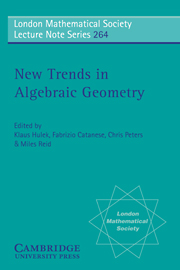Book contents
- Frontmatter
- Contents
- Foreword
- Birational Calabi–Yau n-folds have equal Betti numbers
- A Calabi–Yau threefold with non-Abelian fundamental group
- Algebraic Gromov–Witten invariants
- Kähler hyperbolicity and variations of Hodge structures
- Algorithms for computing intersection numbers on moduli spaces of curves, with an application to the class of the locus of Jacobians
- On some tensor representations of the Cremona group of the projective plane
- Hilbert schemes and simple singularities
- Bounds for Seshadri constants
- Degenerate double covers of the projective plane
- The geometry underlying mirror symmetry
- Duality of polarized K3 surfaces
- On symplectic invariants of algebraic varieties coming from crepant contractions
- The Bogomolov–Pantev resolution, an expository account
- Mordell–Weil lattices for higher genus fibration over a curve
- Symplectic Gromov–Witten invariants
- A generic Torelli theorem for the quintic
- Flops, Type III contractions and Gromov–Witten invariants on Calabi–Yau threefolds
The Bogomolov–Pantev resolution, an expository account
Published online by Cambridge University Press: 04 August 2010
- Frontmatter
- Contents
- Foreword
- Birational Calabi–Yau n-folds have equal Betti numbers
- A Calabi–Yau threefold with non-Abelian fundamental group
- Algebraic Gromov–Witten invariants
- Kähler hyperbolicity and variations of Hodge structures
- Algorithms for computing intersection numbers on moduli spaces of curves, with an application to the class of the locus of Jacobians
- On some tensor representations of the Cremona group of the projective plane
- Hilbert schemes and simple singularities
- Bounds for Seshadri constants
- Degenerate double covers of the projective plane
- The geometry underlying mirror symmetry
- Duality of polarized K3 surfaces
- On symplectic invariants of algebraic varieties coming from crepant contractions
- The Bogomolov–Pantev resolution, an expository account
- Mordell–Weil lattices for higher genus fibration over a curve
- Symplectic Gromov–Witten invariants
- A generic Torelli theorem for the quintic
- Flops, Type III contractions and Gromov–Witten invariants on Calabi–Yau threefolds
Summary
Statement of the result
Bogomolov and Pantev have recently discovered a rather elegant geometric proof of the weak Hironaka theorem on resolution of singularities:
Theorem 0.1Let X be a projective variety and Z a proper Zariski closed subset of X. There is a projective birational map ɛ: X → X such that is smooth and the set theoretic inverse image ɛ−1(Z) is a divisor with simple normal crossings.
Before their work, and that of Abramovich and de Jong (appearing at roughly the same time) the only proof of this theorem was as a corollary of the famous result of Hironaka. These new proofs were inspired by the recent work of de Jong, which Bogomolov and Pantev combine with a beautiful idea of Belyi “simplifying” the ramification locus of a covering of ℙ1 by successively folding up the ℙ1 onto itself, over a fixed base. This latter step unfortunately only works in characteristic zero, limiting the scope of the argument (Abramovich and de Jong's paper gives some results even in characteristic p). Hence, we work over the field of complex numbers; the argument also works (with suitable modifications about rationality) over any field of characteristic zero.
The outline of the argument we follow is the same as that of the paper of Bogomolov and Pantev; however we offer different (and we hope simpler) proofs of the corresponding lemmas. To begin with, their argument using Grassmannians is replaced by an application of Noether normalisation in Section 1.
- Type
- Chapter
- Information
- New Trends in Algebraic Geometry , pp. 347 - 358Publisher: Cambridge University PressPrint publication year: 1999

